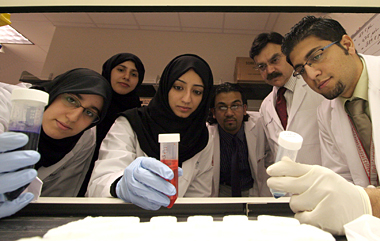Qatar medical students on the move, moving up and moving in
By Lauren Gold

Connecting with Ithaca
Twelve second-year premedical students from Weill Cornell Medical College-Qatar (WCMC-Q) spent summer 2007 in Ithaca working with top researchers on projects that ranged from studying how proteins freeze to testing the effects of a neurotransmitter on epileptic flies.
And building on the success of the summer research fellowships, which began in 2004, the number of funded placements has been increased to 16 for summer 2008. The fellowships, which are awarded by competition, connect WCMC-Q students with researchers at Cornell's main campus in Ithaca and at Weill Cornell Medical College in New York City.

Tania Jaber, originally from Lebanon, studied the genetics of the worm C. elegans last summer with Kelly Liu, professor of molecular biology and genetics. The practical lab experience was invaluable, she said. "Now I actually understand how much effort goes into a research paper."
As for adjusting to life in Ithaca: "It wasn't exactly culture shock -- everyone felt welcome," said Doha native Noora Al-Shahwani, who studied neurobiology with research associate Pat Rivlin. Previously, she and other students had only seen the Ithaca campus via webcast classes.
"We technically belong to this campus," said Jaber as the summer drew to a close. So "it was nice to really be here."
Record number of students enroll in WCMC-Q's programs
The number of students enrolling in the premedical and medical programs this year reached a new high of 91, up from 72 last year.
Thirty students enrolled in the medical Class of 2011. Of these, 28 students successfully completed the premedical program and two are external students. The class celebrated its entry to the medical program at a white-coat ceremony, Sept. 10. Marcellina Mian, professor of pediatrics at WCMC-Q, was the keynote speaker.
Meanwhile, 61 freshmen joined the first year of the two-year premedical program -- the maximum number the Medical College can admit. Among them is the youngest student ever admitted to WCMC-Q, 14-year-old Iqbal El Assaad from Lebanon.
Strong foundations
The Foundation Program, designed for future WCMC-Q students to improve their chances of success in the premedical program, has expanded on the success of its 16-week pilot program.
Eighteen students have joined the new yearlong program, which covers the basic sciences, mathematics and English writing, with an emphasis on critical thinking and problem solving. "The Foundation Program is designed to give students the best possible preparation for entry into the Medical College," said WCMC-Q Dean Daniel R. Alonso.
Researchers identify genetic mutation behind devastating syndromes
Ahmad Teebi, professor of pediatrics and of genetics at WCMC-Q, is part of an international team that linked mutations in the protein-coding gene LRP2 to Donnai-Barrow syndrome (DBS) and facio-oculo-acoustico-renal (FOAR) syndrome. The research was published in the Aug. 8 edition of Nature Genetics.
The syndromes are associated with a spectrum of congenital malformations, including facial dysmorphology, or abnormal development of tissue in the face, deafness, blindness and delayed development.
Because LRP2 encodes megalin, a protein critical for normal embryonic development of the diaphragm, lungs, brain and other organs, the research points the way for possible future drug therapies that target the megalin pathway.
Study reveals potential risk in anti-clotting drug
The anti-clotting drug Idraparinux may have hidden dangers for some patients, according to research published by Bruce Davidson, WCMC-Q professor of medicine, and an international team of investigators in the Sept. 13 edition of the New England Journal of Medicine.
Early, small-scale trials suggested that Idraparinux was a safe and effective alternative to such current treatments as heparin for patients with deep vein thrombosis (DVT) and pulmonary embolism. But phase III clinical trials showed disappointing results in patients with pulmonary embolism (clotting in the lungs) and indicated an increased risk of dangerous bleeding. Even given once weekly, the drug also accumulated in patients.
"Without these large, comparative studies we simply would not catch many of the risks before a drug made its way to patients," said Davidson.
Media Contact
Get Cornell news delivered right to your inbox.
Subscribe